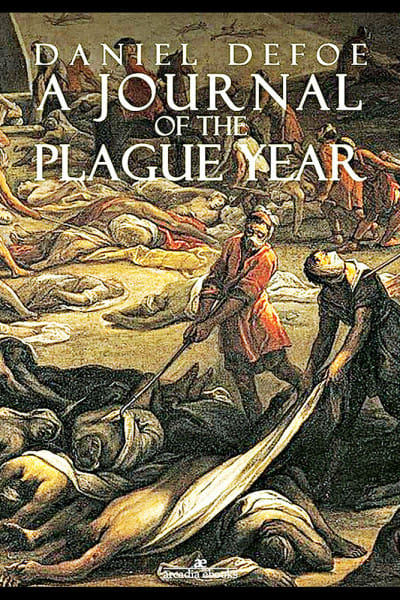London’s 17th-century plague and our global pandemic

Art has always been both a mirror of and a balm for human experience through disaster. In this short series, an author of Daily Star Books—our book publishing imprint—will periodically explore a facet of this link between literature and our ongoing battle with Covid-19.
Leaving death and despair in its wake, the coronavirus courses its way through the globe, reminding one of a Biblical line—"There is no new thing under the sun." History has recorded pandemics raging across the world over time and terrible infections periodically devastating regions and lives. Several great books have been written about such catastrophes; one particularly apt recalling now is Daniel Defoe's A Journal of the Plague Year (1722).
The actual pandemic Defoe writes about is the Great Plague of London. Actually a bubonic plague virulent from 1664 to 1665, it spread quickly to outlying areas of the city. Eventually, it impacted other parts of the British Isles. Defoe himself was only five years old when it hit Londoners and spread across the island, but when he wrote about it, he was already the author of several political pamphlets, a journalist who wrote prolifically on anything and everything, a writer of books on trade and commerce, and of course the creator of pioneering works of fiction such as Robinson Crusoe (1719). He could claim, as had Francis Bacon, that he had taken "all knowledge as his province." Defoe had an eye for what the reading public wanted and would churn out books for them, but many were well-researched. He was, therefore, ready to write about London's bubonic plague, the type of unwelcome visitor he felt Londoners should always be prepared for.
Take, as an example, his observation on the way the plague spread. He noted "for the use of posterity" that it was not only obvious cases of visibly sick people infecting others that one should guard against; even more worrisome were cases where the infection spread through people without outward symptoms, who were unaware that they are virus carriers. Such people "breathed death in every place, and upon everybody who came near them; nay, their very clothes retained the infection, their hands would infect the things they touched, especially if they were warm and sweaty, and they were generally apt to sweat too." Human "effluvia" is seen to be the most potent means of spreading the disease. It is clear that old and sickly people as well as pregnant mothers and the very poor were the most susceptible groups as far as being infected was concerned.
These observations remind us that medical science has known about such highly infectious diseases at least as far back as the Great Plague but has been unable to come up with effective solutions to such dreadful visitations till now. What the Journal's narrator—identified only as H F—said in 1722 is still relevant: "A plague is a formidable enemy, and is armed with terrors that every man is not sufficiently fortified to resist or prepared to stand the shock against."
Indeed, I was struck throughout the narrative by how H F's record of the more than year-long plague is relevant to our times. For instance, the plague virus, like the novel coronavirus today, is an import. The London one apparently came from the Eastern Mediterranean via Italy and Holland; ours perhaps originated in Italy, although the first signs of the pandemic emerged in China.
H F records meticulously the increase in the deaths occasioned by the plague from January 1664 to when it peaked at year-end. He offers statistical information of the exponential increase in fatalities based on computation of the "weekly bill of mortality" of representative parishes. The numbers given are shocking and yet perversely addictive for readers—witness, for example, how we are glued to TV screens in home confinement watching the news ticker reporting the number of deaths day after day—the fascination of the abomination, so to speak!
H F's journal narrates how the mood of Londoners fluctuated, alternating between alarm and hope. Sanguine at one point, they are unaware that the plague was taking a breather in late spring 1665 but would accelerate in September of the same year. We learn that the plague came in two waves, peaking at one point and then receding for a while, only to reappear with more devastating force again. H F describes rich Londoners fleeing to country homes or self-isolating in well-fortified city houses stacked with abundant provisions while the poor were stuck in their ghettos. This reminds me of the way people with means left Bangladesh before flights were suspended, or the relative security that some of us can take advantage of in our apartment buildings, compared to the vulnerability of people helplessly confined to tiny rooms in crowded neighbourhoods in parts of Dhaka now.
H F himself decides to stay in London, despite the option of leaving that people of his class had, trusting in God more than reason in so doing. The city he describes could be easily ours—empty streets, anxious faces, and grieving relatives in houses where inmates had died. The booming, bustling London that Defoe's narrator knew about becomes desolate. Trade—local, national and international—stops. As he puts it after the second viral wave, "This time it was terrible."
H F tells readers how religious fanatics felt that the plague manifested God's judgment on a wicked city and how doomsday men and false prophets suddenly emerged with explanations for the dreadful visitation. He himself is inclined to see things rationally and dismiss such explanations as "blind, absurd and ridiculous stuff". Not an unbeliever though, he approves of public prayers organised by the government to seek God's mercy.
Defoe's narrator decries the false cures of quacks offering "cheap remedies". Instead, and throughout the narrative, he details and commends prudent measures adopted by the London mayor and fellow city administrators, measures worth adopting even now. H F describes the elaborate measures taken—what we now call "lockdown" and "self-isolation"—deploying the forces of law and order fully, isolating infected medical personnel, restricting movement in and out of houses reporting infections, marking them, keeping streets clean, banning public gatherings, adopting strict measures for the burial of the dead, garbage disposal, etc.
But there are other noteworthy measures detailed—the appointment of "searchers" to identify infection carriers and monitor movement of people, ensuring the presence of physicians, and setting forth procedures for the disposal of the dead and their clothes and belongings. He commends the way the Lord Mayor and others lead from the front by patrolling the streets. H F also admires the way the administration ensured "provisions" for all and tried to keep prices stable throughout the plague months. He is all praise for the physicians and attendants who succumbed to the virus in carrying out their duties. The only complaint he has about the administration is that it was able to set up only two "pest houses" for housing the infected.
Nevertheless, some Londoners kept transgressing whatever measures were imposed, either out of necessity or boredom. Even the strict measures imposed often couldn't keep everyone at home, as is the case now. "Desperation" is a word that keeps recurring in the Journal. We realise that the tragedy was a human one, and all human beings don't react in the same way to emergencies. Indeed, H F records a range of emotions on display—agony, despair, grief, morbidity, self-doubt, paranoia, cruelty, callousness, greed, selfishness, complacency, compassion, kindness and courage.
By February 1665, the Great Plague left London to the great relief of all Londoners. Expressions of joy and smiles return to their faces after almost two years and celebrations begin. Defoe concludes his narrative with a "coarse but sincere stanza" to mark its end: "A dreadful plague in London was/in the year sixty-five/ Which swept an [sic] hundred thousand souls? Away;/ Yet I am alive!"
Let us hope the coronavirus will leave people everywhere—near or far—soon and we, too, will be able to celebrate its demise and our survival without too many more fatalities!
Fakrul Alam is UGC Professor, Department of English, University of Dhaka. His book Once More Into the Past: Essays, Personal, Public, and Literary was published by Daily Star Books in February 2020. Follow Daily Star Books on Facebook and @thedailystarbooks on Instagram for updates.

 For all latest news, follow The Daily Star's Google News channel.
For all latest news, follow The Daily Star's Google News channel. 



Comments